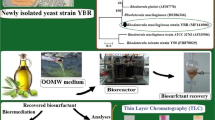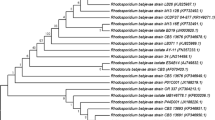Abstract
Microbial surfactants are environmentally friendly products with amazing properties and spectrum of applications. It is therefore, not surprising that research has increased in recent time with the objectives of sourcing for novel surface-active compounds with dual functions in oil and pharmaceutical industries. Evaluation of hydrocarbon degrading potentials and emulsifying activities indicated that biosurfactants were produced by two newly isolated and promising yeast strains, Saccharomyces cerevisiae and Candida albicans, obtained from a polluted lagoon water. Both strains were able to grow effectively on crude oil and diesel as sole sources of carbon and energy. Growth curves on diesel were obtained to establish the relation between cell growth and biosurfactant production. The growth peak was on the 8th day while the specific growth rate ranged insignificantly (P < 0.05) between 0.46 and 0.48 day−1. Interestingly, biosurfactant was detected on the 2nd day when growth was almost inexistent, with maximal production obtained at stationary/death phase of growth. The partially-purified biosurfactants exhibited antimicrobial activities by completely inhibiting the growth of clinical strains of Escherichia coli and Staphylococcus aureus at all concentrations tested. Although C. albicans appeared to be a better diesel-utilizer and biosurfactant-producer (E24 = 64.2%), the potency of its surfactant was smaller than that of S. cerevisiae. These strains represent a new class of biosurfactant producers that have potential for use in a variety of biotechnological and industrial processes particularly in the pharmaceutical industry.


Similar content being viewed by others
References
Abu-Ruwaida AS, Banat MH, Salem S, Kadiri A (1991) Isolation of biosurfactant producing bacteria product characterization and evaluation. Acta Biotechnol 11:315–324. doi:10.1002/abio.370110405
Banat IM (1995) Biosurfactant production and possible uses in microbial enhanced oil recovery and oil pollution remediation: a review. Bioresour Technol 51:1–12. doi:10.1016/0960-8524(94)00101-6
Barnett JA, Pankhurst RJ (1974) A new key to the yeasts. North Holland Publishing Co, Amsterdam
Bauchop T, Elsden SR (1969) The growth of microorganisms in relation to their energy. J Gen Microbiol 23:457–469
Bicca FC, Fleck LC, Zachio MA (1999) Production of biosurfactant by hydrocarbon degrading Rhodococcus rubber and Rhodococcus erythropolis. Rev Microbiol 30:231–236. doi:10.1590/S0001-37141999000300008
Bodour AA, Maier MR (2002) Biosurfactants:types, screening methods, and applications. In: Bitton G (ed) Encyclopedia of environmental microbiology. John Wiley and Sons, New York, pp 750–770
Bodour AA, Drees KP, Maier M (2003) Distribution of biosurfactant-producing microorganisms in undisturbed and contaminated arid southwestern soils. Appl Environ Microbiol 69:3280–3287. doi:10.1128/AEM.69.6.3280-3287.2003
Bodour AA, Gerrero-Barajas C, Jiorle BV, Malcomson ME, Paull AK, Somogyi A et al (2004) Structure and characterization of flavolipids, a novel class of biosurfactants produced by Flavobacterium sp. strain MTN11. Appl Environ Microbiol 70:114–120. doi:10.1128/AEM.70.1.114-120.2004
Branda SS, Gonzalez-Pastor JE, Ben-Yehuda S, Losick R, Kolter R (2001) Fruiting body formation by Bacillus subtilis. Proc Natl Acad Sci USA 98:11621–11626. doi:10.1073/pnas.191384198
Bushnell ID, Hass HE (1941) Utilization of certain hydrocarbon by microorganisms. J Bacteriol 41:653–658
Cameron DR, Cooper DG, Neufeld RJ (1988) The mannoprotein of Saccharomyces cerevisiae in an effective bioemulsifier. Appl Environ Microbiol 54:1420–1425
Davey ME, Caiazza NC, O’Toole GA (2003) Rhamnolipid surfactant production affects biofilm architecture in Pseudomonas aeruginosa PAO1. J Bacteriol 185:1027–1036. doi:10.1128/JB.185.3.1027-1036.2003
Desai JD, Banat IM (1997) Microbial production of surfactants and their commercial potential. Microbiol Mol Rev 61:47–64
Deziel E, Paquette G, Villemur R, Lepine F, Bisaillon J (1996) Biosurfactant production by soil Pseudomonas strain growing on polycyclic aromatic hydrocarbons. Appl Environ Microbiol 62:1908–1912
Garcia-Ochoa F, Casas JA (1999) Unstructured kinetic model for sophorolipid production by Candida bombicola. Enzyme Microb Technol 25:613–621. doi:10.1016/S0141-0229(99)00089-7
Georgiou G, Lin S, Sharma MM (1992) Surface-active compounds from microorganisms. Biotechnol 10:60–65. doi:10.1038/nbt0192-60
Ilori MO, Amund OO (2001) Production of a peptidoglycolipid bioemulsifier by Pseudomonas aeruginosa grown on hydrocarbon. Z Naturforsch 56C:547–552
Ilori MO, Amobi CJ, Odocha AC (2005) Factors affecting biosurfactant production by oil degrading Aeromonas spp. isolated from a tropical environment. Chemosphere 61:985–992. doi:10.1016/j.chemosphere.2005.03.066
Jain DK, Thompson DLC, Lee H, Trevors JT (1991) A drop-collapsing test for screening surfactant producing microorganisms. J Microbiol Methods 13:271–279. doi:10.1016/0167-7012(91)90064-W
Jennings EM, Tanner RS (2000) Biosurfactant-producing bacteria found in contaminated soils. Proceedings of 2000 conference on hazardous waste reseach, pp 299–306
Karanth NGK, Deo PG, Veenanadig NK (1999) Microbial production of biosurfactants and their importance. Curr Sci 77:116–126
Kästner M, Breuer-Jammali M, Mahro B (1994) Enumeration and characterization of the soil microflora from hydrocarbon-contaminated soil sites able to mineralize polycyclic aromatic hydrocarbons (PAH). Appl Microbiol Biotechnol 41:267–273. doi:10.1007/BF00186971
Kim S, Lim E, Lee S, Lee J, Lee T (2000) Purification and characterization of biosurfactant-producing Bacillus species. Biotechnol Appl Biochem 31:249–253. doi:10.1042/BA19990111
Kitamoto D, Yanagishita H, Shinbo T, Makane T, Kamisawa C (1993) Surface active properties and antimicrobial activities of mannosylerythritol lipids as biosurfactant produced by Candida antartica. J Biotechnol 29:91–96. doi:10.1016/0168-1656(93)90042-L
Kosaric N (1992) Biosurfactants in industry. Pure Appl Chem 64(11):1731–1737
Kumar M, Leon V, Materano ADS, Ilzins OA (2006) Enhancement of oil degradation by co-culture of hydrocarbon degrading and biosurfactant producing bacteria. Pol J Microbiol 55:139–146
Lin SC (1996) Biosurfactant: recent advances. J Chem Technol Biotechnol 66:109–120. doi:10.1002/(SICI) 1097-4660(199606)66:2<109::AID-JCTB477>3.0.CO;2-2
Nwachukwu SCU, Ugoji EO (1995) Impacts of crude petroleum spills on microbial communities of tropical soils. Int J Ecol Environ Sci 21:359–366
O’Donnell KL (1979) Zygomycetes in culture. Palfery Contributions in Botany, Department of Botany, University of Georgia, USA, Athens
Paraszkiewicz K, Kanwa A, Dlugonski J (2002) Emulsifier production by steroid transforming filamentous fungus Curvularia lunata. Growth and product characterization. J Biotechnol 92:287–294. doi:10.1016/S0168-1656(01)00376-5
Rashid MH, Rumbaugh K, Passador L, Davies DG, Hamood AN, Iglewski BH, Kornberg A (2000) Polyphosphate kinase is essential for biofilm development, quorum sensing, and virulence. Proc Natl Acad Sci USA 97:9636–9641. doi:10.1073/pnas.170283397
Razafindralambo H, Paquot M, Baniel A, Popineau Y, Hbid C, Jacques P, Thonart P (1996) Foaming properties of surfactin, a lipopeptide biosurfactant from Bacillus subtilis. J Am Oil Chem Soc 73:149–151
Raymond RL, Hudson JO, Jamison VW (1976) Oil degradation in soil. Appl Environ Microbiol 31:522–535
Richter M, Willey JM, Sussmuth R, Jung G, Fiedler H-P (1998) Streptofactin, a novel biosurfactant with aerial mycelium inducing activity from Streptomyces tendae Tu 901/8c. FEMS Microbiol Lett 163:165–171
Rodrigues L, Van der Mei H, Teixeira J, Oliveira R (2004) Biosurfactant from Lactobacillus lactis 53 inhibits microbial adhesion on silicone rubbber. Appl Microbiol Biotechnol 66:306–311. doi:10.1007/s00253-004-1674-7
Rodrigues L, Moldes A, Teixeira J, Oliveira R (2006) Kinetic study of fermentative biosurfactant production by Lactobacillus strains. Biochem Eng J 28:109–116. doi:10.1016/j.bej.2005.06.001
Sarubbo LA, de Luna JM, de Campos-Takaki GM (2006) Production and stability studies of the bioemulsifier obtained from a new strain of Candida glabrata UCP 1002. Electron J Biotechnol 9:6. doi:10.2225/vol9-issue4-fulltext-6
Shepherd R, Rockey J, Sutherland IW, Roller S (1995) Novel bioemulsifier from microorganisms for use in foods. J Biotechnol 40:207–217. doi:10.1016/0168-1656(95)00053-S
Smith G (1969) Classification and identification of fungi, 6th edn. Edward Arnold, London
Stelmack PL, Gray MR, Pickard MA (1999) Bacteria adhesion to soil contaminants in the presence of surfactants. Appl Environ Microbiol 65:163–168
Tabatabaee A, Assadi MM, Noohi AA, Sajadian VA (2005) Isolation of biosurfactant producing bacteria from oil reservoirs. Iranian J Environ Health Sci Eng 2:6–12
Tuleva BK, Ivanov GR, Christova NE (2002) Biosurfactant production by a new Pseudomonas putida strain. Z Naturforsch 57C:356–360
Vater PJ (1986) Lipopeptides, an attractive class of surfactants. Prog Colloid Polym Sci 72:12–18. doi:10.1007/BFb0114473
Velikong J, Kosaric N (1993) Biosurfactant in food applications. In: Kosaric N (ed) Biosurfactants: production, properties, applications. Marcel Dekker Inc., New York, pp 419–446
Vollenbroich D, Pauli G, Ozel M, Vater J (1997) Antimycoplasma properties and application in cell culture of surfactin, a lipopeptide antibiotic from Bacillus subtilis. Appl Environ Microbiol 63:44–49
Zajic JE, Guignard H, Gerson DF (1977) Properties and biodegradation of a bioemulsifier from Corynebacterium hydrocarboclastus. Biotechnol Bioeng 19:1303–1320
Zinjarde SS, Pant A (2002) Emulsifier from a tropical marine yeast, Yarrowia lipolytica NCIM 3589. J Basic Microbiol 42:67–73. doi:10.1002/1521-4028(200203)42:1<67::AID-JOBM67>3.0.CO;2-M
Acknowledgements
The first author would like to thank Alexander von Humboldt Stiftung, Bonn, Germany for the award of a Fellowship and donation of some of the equipment used for this work. Technical supports from Professors I. Schuphan and U. Klinner of Aachen Technical University, Germany are highly appreciated.
Author information
Authors and Affiliations
Corresponding author
Rights and permissions
About this article
Cite this article
Ilori, M.O., Adebusoye, S.A. & Ojo, A.C. Isolation and characterization of hydrocarbon-degrading and biosurfactant-producing yeast strains obtained from a polluted lagoon water. World J Microbiol Biotechnol 24, 2539–2545 (2008). https://doi.org/10.1007/s11274-008-9778-3
Received:
Accepted:
Published:
Issue Date:
DOI: https://doi.org/10.1007/s11274-008-9778-3




